 Afrikaans
Afrikaans  Albanian
Albanian  Amharic
Amharic  Arabic
Arabic  Armenian
Armenian  Azerbaijani
Azerbaijani  Basque
Basque  Belarusian
Belarusian  Bengali
Bengali  Bosnian
Bosnian  Bulgarian
Bulgarian  Catalan
Catalan  Cebuano
Cebuano  Corsican
Corsican  Croatian
Croatian  Czech
Czech  Danish
Danish  Dutch
Dutch  English
English  Esperanto
Esperanto  Estonian
Estonian  Finnish
Finnish  French
French  Frisian
Frisian  Galician
Galician  Georgian
Georgian  German
German  Greek
Greek  Gujarati
Gujarati  Haitian Creole
Haitian Creole  hausa
hausa  hawaiian
hawaiian  Hebrew
Hebrew  Hindi
Hindi  Miao
Miao  Hungarian
Hungarian  Icelandic
Icelandic  igbo
igbo  Indonesian
Indonesian  irish
irish  Italian
Italian  Japanese
Japanese  Javanese
Javanese  Kannada
Kannada  kazakh
kazakh  Khmer
Khmer  Rwandese
Rwandese  Korean
Korean  Kurdish
Kurdish  Kyrgyz
Kyrgyz  Lao
Lao  Latin
Latin  Latvian
Latvian  Lithuanian
Lithuanian  Luxembourgish
Luxembourgish  Macedonian
Macedonian  Malgashi
Malgashi  Malay
Malay  Malayalam
Malayalam  Maltese
Maltese  Maori
Maori  Marathi
Marathi  Mongolian
Mongolian  Myanmar
Myanmar  Nepali
Nepali  Norwegian
Norwegian  Norwegian
Norwegian  Occitan
Occitan  Pashto
Pashto  Persian
Persian  Polish
Polish  Portuguese
Portuguese  Punjabi
Punjabi  Romanian
Romanian  Russian
Russian  Samoan
Samoan  Scottish Gaelic
Scottish Gaelic  Serbian
Serbian  Sesotho
Sesotho  Shona
Shona  Sindhi
Sindhi  Sinhala
Sinhala  Slovak
Slovak  Slovenian
Slovenian  Somali
Somali  Spanish
Spanish  Sundanese
Sundanese  Swahili
Swahili  Swedish
Swedish  Tagalog
Tagalog  Tajik
Tajik  Tamil
Tamil  Tatar
Tatar  Telugu
Telugu  Thai
Thai  Turkish
Turkish  Turkmen
Turkmen  Ukrainian
Ukrainian  Urdu
Urdu  Uighur
Uighur  Uzbek
Uzbek  Vietnamese
Vietnamese  Welsh
Welsh  Bantu
Bantu  Yiddish
Yiddish  Yoruba
Yoruba  Zulu
Zulu conveyor roller assembly
Understanding Conveyor Roller Assembly A Key Component in Material Handling
Conveyor roller assembly plays a critical role in the material handling industry, facilitating the movement of goods and materials across various industries. Efficient and reliable, these assemblies are essential for the optimal performance of conveyor systems, ensuring smooth operations in warehouses, manufacturing plants, and distribution centers.
At its core, a conveyor roller assembly consists of several components that work together seamlessly. Typically, the main components include rollers, shafts, bearings, and frames. The rollers are cylindrical elements that bear the load and facilitate the movement of materials along the conveyor belt. They can be made from various materials, such as steel, plastic, or rubber, depending on the application and the weight of the items being transported.
Understanding Conveyor Roller Assembly A Key Component in Material Handling
The frame of the roller assembly is designed to hold all the components in place and ensure that they align properly within the conveyor system. A robust frame is essential for maintaining the durability and stability of the assembly, especially when handling heavy loads or operating in demanding environments.
conveyor roller assembly

One significant advantage of conveyor roller assemblies is their versatility. They can be designed for various applications, including gravity roller conveyors, powered roller conveyors, and belt conveyors. Each system can be tailored to meet specific operational needs, such as the type of materials being handled and the layout of the workspace. For instance, gravity roller conveyors are ideal for moving lightweight items down an incline, while powered roller systems can handle heavier loads over longer distances.
Regular maintenance of conveyor roller assemblies is also vital to ensure their longevity and efficiency. Routine inspections should check for signs of wear and tear, such as damaged rollers or bearings. Lubricating the bearings and replacing worn parts can help prevent unexpected downtime and costly repairs. Implementing a preventative maintenance schedule can lead to significant cost savings in the long run.
In recent years, advancements in technology have further enhanced the effectiveness of conveyor roller assemblies. Innovations such as smart sensors and automated monitoring systems allow for real-time tracking of conveyor performance. These technologies enable early detection of issues, leading to swift corrective action and minimizing operational disruptions.
In conclusion, conveyor roller assemblies are indispensable in the efficient operation of material handling systems. Their design, maintenance, and integration into broader logistical operations are pivotal for industries dependent on the seamless movement of goods. Understanding the components and functions of these assemblies can lead to improved operational efficiency, reduced costs, and ultimately, greater productivity. As industries continue to evolve, the importance of reliable conveyor roller assemblies will only increase, making them a critical factor in modern manufacturing and distribution practices.
-
Revolutionizing Conveyor Reliability with Advanced Rubber Lagging PulleysNewsJul.22,2025
-
Powering Precision and Durability with Expert Manufacturers of Conveyor ComponentsNewsJul.22,2025
-
Optimizing Conveyor Systems with Advanced Conveyor AccessoriesNewsJul.22,2025
-
Maximize Conveyor Efficiency with Quality Conveyor Idler PulleysNewsJul.22,2025
-
Future-Proof Your Conveyor System with High-Performance Polyurethane RollerNewsJul.22,2025
-
Driving Efficiency Forward with Quality Idlers and RollersNewsJul.22,2025





























